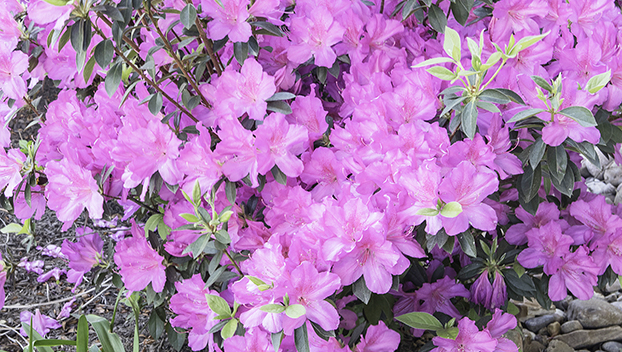TEXAS CERTIFIED EXPERT GARDENER — Azaleas help create magnificent landscape spectacles
Published 12:12 am Wednesday, February 21, 2024

- Azaleas can add a dramatic abundance of color to our SETX neighborhoods and landscapes. There are numerous varieties that can thrive in our environment if adequately planted and nurtured. (oursouthernlife.com)
|
Getting your Trinity Audio player ready...
|
There are but a few weeks of winter remaining before spring officially arrives for Southeast Texas.
Spring is my favorite season though it is a bit hectic. As gardeners, we have numerous gardening tasks which require focused attention: weed removal, incorporating soil amendments into vegetable & flower beds, planting trees, shrubs, flowers & vegetables, dethatching lawns, and equipment & garden tool maintenance (for those gardeners who decided to wait until later-ouch).
While there are many tasks and our gardening chore list is long, we are fortunate as our spring weather cooperates (for the most part) making outdoor activities pure enjoyment especially gardening tasks.
Spring (my favorite gardening season) is always the busiest for me because too many tomato & pepper seeds (as well as numerous other vegetable varieties) have been germinated, that require transplanting soon.
Did I mention multiple purchases of citrus & fruiting trees, shrubs, and perennials?
Gardeners, most of you do the same (so don’t even think about rolling your eyes). All gardeners rejoice welcoming a new growing season, it’s our way of declaring “Welcome Back Spring!”
Each passing week, spring draws closer, and my excitement & anticipation build. Gardening chores, such as weed removal and ‘top-dressing’ raised beds with soil amendments (composted manure) are well under way, in preparation for transplanting ‘tender’ vegetables.
Many of you are also busy making gardening areas ready to accept trees, flowers and vegetables but don’t forget to make some time to enjoy the beautiful sights of spring: Azaleas!
Every spring as gardeners, we look forward to the Azaleas’ flush, since most often this means cold winter temperatures are now behind us and the warmth of spring is at hand.
Azaleas create dramatic focal points in our landscapes as individual or mass plantings. An azalea neatly tucked away near a structure, entryway or beneath a large pine or oak tree provide color with subtlety.
Mass planting azaleas provides a far greater, explosive burst of color and choosing a wooded site, such as a pine stand, creates a bold yet colorful contrast to the grayish-brown back drop. Spring flush (blooms) completely envelope the bush for 2-3 weeks or slightly longer, the remainder of the year the azalea will be a beautiful dark green foliage plant.
There are many varieties of azaleas, and most azalea blooms grow in clusters, ‘trusses’ that are trumpet-shaped, 1-2” flowers, though a few varieties have blooms to 4-inches. Azalea flower colors can be almost any color except blue. Most colors are in variations of pink, i.e., speckled, blotched or bicolor.
Flowers can be single, double-petaled or hose-in-hose (one flower in another flower). Providing some initial effort, all gardeners who grow azaleas will be rewarded for many years with wonderful springtime blooms.
PLANTING
Azaleas require specific care, starting with how you plant them. Choose a location for them to grow ensuring the area selected receives significant sunlight exposure but provides ‘dapple’ shade. Azaleas thrive when grown beneath partial cover as provided by tall trees.
They require enriched, well-drained, acidic soil which doesn’t allow roots to remain standing in water. This can be problematic since most of us have clay soil but easily remedied using soil amendments.
They enjoy direct morning sunlight, so plant them facing East. Late spring or early fall are best for planting. Provide them enough space to grow to maturity, usually 3 to 8-feet apart. Dig a hole twice the size of the purchased container, yet same depth as the root ball. Gently loosen the root ball and place it into the hole covering with about half the removed soil and water deeply.
Once water is absorbed, add the remainder of the soil and water well. Place a 2-inch layer of pine bark or pine shavings as mulch around the perimeter to retain moisture and encourage soil acidity as the mulch decomposes.
UPKEEP
There are few insects which “snack” on Azaleas, unless they receive too much sunlight, then Lace Bugs might do a bit of damage but not often. If the correct amount of moisture & fertilizer is provided most pathogens, including ‘root rot’ will not be a problem but also remember to remove dead or diseased limbs from the shrubs’ structure.
Evenly water Azaleas, never allow the soil to dry completely or to become waterlogged. Areas receiving full sun require more frequent, thorough watering where each plant receives at minimum 1-inch of water weekly. In hotter months, more water is required! Water early in the morning since allowing water to remain on leaves overnight increases the likelihood of fungal diseases.
Azaleas require minute amounts of fertilizer and have similar requirements to camelias, hydrangeas, and blueberries. My recommendation is to use organic fertilizers specifically formulated for acid loving plants following the manufacturers guidelines, since over fertilizing will prove devastating (learn from my experience, less is truly best).
Fertilize plants in spring and again in late Fall, using about half the Spring dose rate. In Spring feed Azaleas as first blooms appear for the best results. Dose rate is about a cup per foot of branch spread (from one end of the plant to the other) or double if the amount branch spread exceeds 3 feet. Sprinkle around the drip line and water thoroughly.
PRUNING
Azaleas require little pruning and if needed, timing is critical. Prune in Spring immediately following the end of the blooming period, any later could hamper blooms for the next season. Remove diseased or dead branches at any time. A good practice is to remove overgrown branches maintaining ‘compactness’ which allows for healthy blooms.
VARIETIES
Native azaleas are adapted to our region (zones 7 – 9) and some have fragrances. My favorite, ‘Alabama’ with large white flowers and mottled with yellow spots having a ‘lemony’ scent. Another favorite, ‘Texas’ has pink or white, funnel-shaped flowers which are slightly fragrant.
‘Koromo Shikibu’ is fragrant having pink (spider-like) flowers. Autumn leaf colors are simultaneously dark red, purple, orange and gold.
Reblooming azaleas initially bloom in spring and then rest presenting another flush through summer. ‘Autumn Fire’ has double blooms in spring with robust red color, reblooming until fall. The dark green foliage turns purple in the fall. ‘Autumn Trust’ with large, bicolor flowers that are lavender-pink with dark pink (mottled) highlights spring through fall.
QUICK TIPS FOR SUCCESS:
- Start with a soil analysis (contact the county extension agent who will provide specific steps to capture soil samples), do not guess otherwise money, energy, and time are wasted! The cost is minimal (less than $20), but the resulting information provided by the analysis is invaluable!
- Azaleas require acidic soil. Do not plant azaleas deeply, especially in our clay soil. Simply plant the bush 1-2” above existing soil grade,
- Provide moist, friable, and well-amended soil. Well-drained soil is a requirement, or risk losing the plant in winter.
- Azaleas need afternoon shade or filtered light throughout the day. Morning sun is preferable.
- During the 1st season or two, never allow azaleas to dry out until established. Providing regular moisture is necessary for the development of good root systems.
- Do not cultivate the soil around the azaleas drip line. Azalea roots grow close to the surface and are easily damaged.
Send Certified Texas Expert Gardener John Green your questions and please continue sending comments to jongreene57@gmail.com.





